Content
- 1 Description, varieties and photos of streptocarpus
- 2 Natural species of streptocarpus - photo
- 3 Collectible varieties of streptocarpus - photo
- 4 Flower properties and care rules
- 5 Temperature regime
- 6 Illumination
- 7 Watering the plant
- 8 Reproduction
- 9 Potential Problems and Necessary Tips
- 10 Photo of streptocarpus
- 11 Description of streptocarpus
- 12 Home care for streptocarpus
- 13 Reproduction of streptocarpus by dividing the bush
- 14 Reproduction of streptocarpus leaf
- 15 How to plant streptocarpus children
- 16 Streptocarpus from seeds at home
- 17 Diseases and pests of the streptocarpus plant
- 18 Streptocarpus varieties with photos and names
 In difficult room conditions, at unstable temperatures and practically any air humidity, streptocarpus will grow well and bloom profusely. This unpretentious plant with a difficult to pronounce name has a shortened stem, pubescent leaves and flowers of a wide variety of colors. To date, breeders have bred many varieties of abundantly and beautifully flowering streptocarpus, photos of which are presented in our gallery.
In difficult room conditions, at unstable temperatures and practically any air humidity, streptocarpus will grow well and bloom profusely. This unpretentious plant with a difficult to pronounce name has a shortened stem, pubescent leaves and flowers of a wide variety of colors. To date, breeders have bred many varieties of abundantly and beautifully flowering streptocarpus, photos of which are presented in our gallery.
Description, varieties and photos of streptocarpus
Streptocarpus is a rosette plant with broad, lanceolate leaves and a short stem. Leaves can be green or variegated. In their axils, one or two flowers grow like a long spiral box.
Today there are more than 130 thirty varieties streptocarpus. They are all divided into three types:
- The stem type is a creeping plant that blooms profusely with small flowers.
- The rosette type includes hybrid varieties with large flowers formed into a rosette.
- The single-leaved type is a plant whose main leaf can be up to one meter long and 60 cm wide. Some varieties of this type may have a pair of underdeveloped auxiliary leaves.
The most popular among florists hybrid rosette streptocarpus... Most of them are distinguished by green, wide, wrinkled leaves, in the axils of which there are one or two peduncles.
The flowers of hybrid varieties reach 4 cm in diameter.If measured together with the limb, they can measure up to 8 cm in diameter. Petals can be plain, double, fancy, or corrugated. Most often they are purple or bluish in color. However, breeders have bred streptocarpus hybrids with pink, white, red and black flowers. They can even have various patterns, specks and stripes.
Natural species of streptocarpus - photo
Since flower growers have recently begun to prefer modern hybrids, wild-growing streptocarpuses are grown at home less and less. The most popular types include:
-
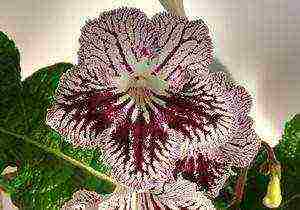 Streptocarpus royal is distinguished by long drooping leaves, growing up to 25 cm. Its flowers are bright purple in color inside the throat have purple streaks and stripes.
Streptocarpus royal is distinguished by long drooping leaves, growing up to 25 cm. Its flowers are bright purple in color inside the throat have purple streaks and stripes. - Streptocarpus stele-forming is a plant, the stem of which grows up to 40-60 cm. Its drooping flowers are pale blue in color.
- Streptocarpella Kirka is an ampelous plant that grows up to 15 cm. Light purple inflorescences in the form of umbrellas are formed on it.
- Streptocarpus Vendlana is a beautiful plant with one large wide-oval leaf, the length of which reaches 90 cm. Above, a wrinkled and drooping leaf is green, and below it is red-purple.The long peduncle consists of 15-20 violet-blue flowers. This type of plant reproduces only by seed, and dies after flowering.
- Rocky streptocarpus is a perennial plant with a woody base. Its pubescent oval leaves are small. The shoots are twisted at the ends. In summer and autumn, the plant blooms with medium-sized purple flowers.
Collectible varieties of streptocarpus - photo
In flower shops, you can most often see streptocarpus monochromatic white, pink or purple hue... On the Internet, it will not be difficult to choose a hybrid streptocarpus with double or simple flowers of any color.
Domestic varieties of streptocarpus: photo, name, description
Very beautiful and diverse varieties of selection CF... The most popular of them are:
- Variety CF-Amaretto is a plant with a standard rosette and light green leaves. Large lilac-pink flowers in the middle have a large yellow spot. The upper part of the neck is white.
- The CF-Baltic Sea variety blooms for a long time and profusely with large blue-violet flowers. The neck of the velvety flowers has a white tint. The lower petals are darker than the upper ones.
- Variety CF-Valentina is distinguished by bright lingonberry huge flowers, the petals of which are bent back. The standard outlet consists of bright green foliage.
- Variety CF-Juliet is a plant with a compact rosette and green leafy medium size. The flowers are composed of petals of different colors. The lower wavy petals have a purple hue and a black mesh pattern. Strongly crimped top petals in a solid lilac color.
- Variety TsF-Zapolyarye - the plant is distinguished by flowers, the pattern of which resembles the northern lights. At the base of its three lower petals, there is a blurred lilac spot with a mesh pattern. The sides of the white throat are decorated with dark purple stripes, and there is a yellow spot at the bottom.
Streptocarpus varieties deserve special attention from the selection of Vyacheslav Paramonov... Among them are:
-
 The variety "Marine Patterns" is a plant with very large flowers. Their white, wavy petals are covered with a blue-purple mesh.
The variety "Marine Patterns" is a plant with very large flowers. Their white, wavy petals are covered with a blue-purple mesh. - The variety "Snow Kilimonjaro" is distinguished by huge snow-white flowers with corrugated edges and green, wavy leaves. The neck is covered with a light purple coating.
- Variety "Spring Dreams" is a plant with very large white-pink flowers. Their petals, crimped along the edge, are strewn with lavender veins.
- The "Envy of the Gods" variety is a plant with wavy green leafy and corrugated white flowers. A pink-crimson mesh is drawn across the entire surface of the petals. The neck is marked with cherry stripes.
Foreign varieties of streptocarpus - photo
Very beautiful and varied in shape, size and color of the variety, bred by foreign breeders... Among florists, the following are the most popular:
-
 The Sylvie variety, named after the Queen of Sweden, has a highly jagged foliage and corrugated bicolor petals. The lower, elongated petals are bright yellow, and the upper ones are purple in color.
The Sylvie variety, named after the Queen of Sweden, has a highly jagged foliage and corrugated bicolor petals. The lower, elongated petals are bright yellow, and the upper ones are purple in color. - The Snow Rose variety is a plant with dense green foliage and original large flowers. Wavy smoky pink petals are painted with cherry red strokes.
- The Saltenz Rubi variety is a truly royal plant. Saintpaulia of this variety blooms with very large, wavy, luxurious burgundy flowers with a white-pink neck. The jagged foliage is green.
- The Blue Harmony variety is a streptocarpella with long branchy shoots covered with fleecy leaves. The small size light blue flowers grow on thin long peduncles. Blooms profusely and for a long time.
Due to a variety of hybrid varieties, streptocarpus become collectible and settled in the houses of both experienced flower growers and those who are just starting to grow flowers.
Streptocarpus flower varieties
I suggest creating a list and sharing your impressions of the best varieties.
I understand that "the best is the one that I like" (AB Pugacheva).
But, completing (temporarily, no conditions, heat without ventilation) a 5-year epic of choosing and growing many varieties from free access (from the Head, who knows), for a start I would like to share my purely personal, partially objective observations and a list of the best, beginner-friendly varieties.
Selection criteria - chic, size, longevity of the flower.
And yes, suitability for cutting - straps give a wonderful bouquet for a week in the water.
Vitality / stability / size - depends purely on the conditions of detention.
1. DS-Strawberry. A huge hat of medium-sized (5 cm) flowers of strawberry color in the first year from autumn seedlings. Gorgeous in spring, flowers last more than a week. In summer, bluishness appears, the petals become thinner.
Peduncles are not thick but strong.
2. DS-Birth of Dawn, Tenderness, Young Lady. Similar bouquet varieties are also pinkish-yellow-creamy with a blue stripe. Gorgeous, tall (peduncles), rather large flowers with a cap, last for a long time.
3. DS-Himalayas. A huge (9cm) thick corrugated flower of a mattress-white striped color on a long thick cut peduncle. Lasts more than a week. There are not many flowers (up to 5 in a row) but they are gorgeous. A must have for everyone.
4. DS-Kata-Tjuta. Everyone knows this, it looks like he is on the cover of Yenikeev's book.
Tall, reliable, rather large, perhaps the most persistent of those that come across, multiplies without problems. Not a bouquet. Like pansies.
5. DS- Yarilo. Huge (perhaps the largest flower) bells (3-4 pieces) of a red-bluish hue. The size can outshine the neighbors, but the peduncles are short. Holds up enough. Simple like that.
6. DS- "Giraffe". Very beautiful and persistent pink flowers with a yellow throat (with proper care, they are large on very high strong cut peduncles.
It attracts attention, the wow effect is similar to the Himalayas. Flowers are few but noticeable.
7. "Mira" With good watering / fertilization, the flowers are very large and delicate in color, not a bouquet but lasts a long time and the flower stalks are tall and strong.
8. 1047 "Vanda" - almost a bouquet, rather large with a bright yellow-cream beard with a brick-red stripe. They also last for a long time, a bright spring bouquet, a wonderful cut.
9. Abrau-Durso. Wonderful pale pink large tangle, only the peduncles under the flower break, but impressive.
All varieties are quite large bush, seedlings were planted immediately in 12-14 cm pots, they live for a couple of years without transshipment and problems.
Streptocarpus is a plant that is now gaining popularity among all gardeners and florists as a house plant of the Gesnerian genus. And they fall in love with this plant because it blooms for a long time, and the inflorescences are brightly colored.

This plant came to our country from South Africa, where forest mountains are the natural environment for its existence. There are more than 130 species of wild streptocarpus. Breeders to this day are developing new varieties, both wild and domestic plant species.

If someone has not seen, then a photo of streptocarpus can be seen on the Internet.
Flower properties and care rules
Oddly enough, streptocarpus does not have a stem, but its leaves are rather large and elongated. The leaves are fleshy, on the outside they have soft villi, which are collected in a huge rosette. One inflorescence can grow from each such outlet.

There are common varieties and elite varieties. In elite varieties, a streptocarpus flower can bloom several pieces from one sinus. After the flowering process, fruits are formed on the plant.

The fruits are twisted capsules with small seeds inside.

Caring for and growing streptocarp may differ from caring for other plants.
So, in order for the plant to thank you with its lush inflorescences, you should organize the competent care of streptocarpus at home.

Temperature regime
Streptocarpus is a plant that loves warmth very much. The optimal temperature regime is +20, +25. In winter, the temperature can be reduced to +16, +17.

Direct drafts should not be allowed on the plant. It is better not to store a houseplant on the balcony and on the street.

Illumination
The plant loves light. But here we are not talking about direct sunlight, but about diffused light. In summer, it is recommended to place the plant on the western or eastern windows.
If you put it on the south side, then you can expect a burn from excessive direct rays of the sun, and in the northern part there will be insufficient illumination.

Diffused light for a plant can be provided by special store phytolamps. With such lamps, the plant can be stored even in a deeply dark place.
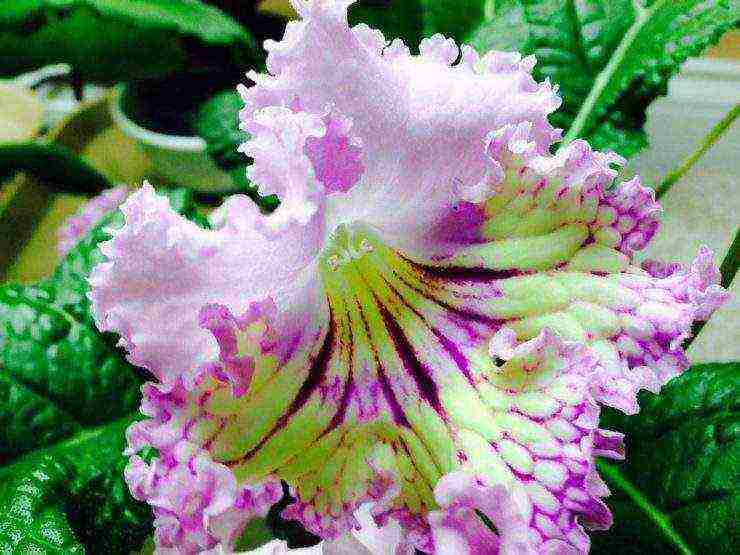
Watering the plant
It is impossible to pour over the plant completely, from this the leaves and the stem, and accordingly, the plant itself, may die. Proper soil moistening is required for streptocarpus.
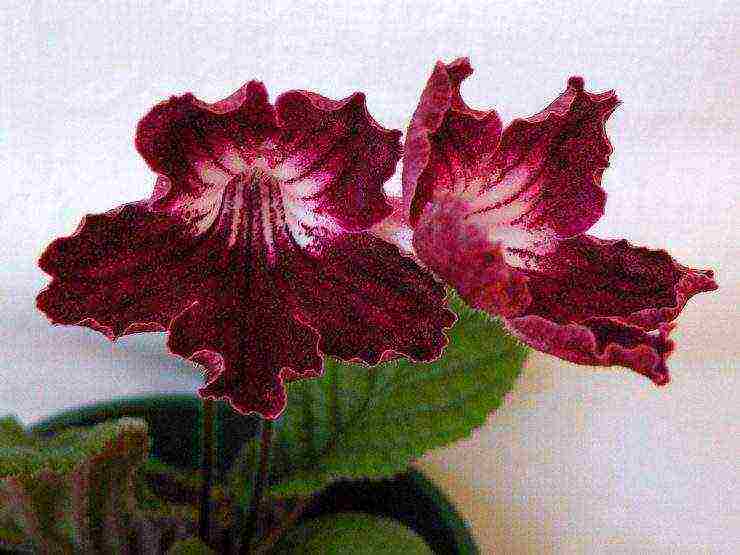
Choose the right pot - it should be short but wide enough. The root of the plant does not grow in length, but in width.

Watering should not be plentiful, as for some plants, moderate watering is sufficient. For example, every two to three days. The water should be soft.

Reproduction
Plant transplantation can be carried out in several ways: by seeds from fruits, cuttings, as well as by dividing the bush. You can learn more about these methods on the Internet.

Potential Problems and Necessary Tips
Streptocarpus often needs to be examined for disease or pest parasites.
If you see the first signs of plant wilting, then take immediate action to eliminate them before it's too late:
- Isolate a rapidly diseased plant. Otherwise, the disease can go to other flowers;
- Only damaged parts of the plant can be removed. For example, flower buds or leaves;
- Treat the soil under the plant with special solutions or insecticides;
- In case of stem or leaf disease, the entire plant should be treated with fungicidal agents;
- If the leaves are covered with mosaic spots, then isolate the plant as soon as possible, without sparing;
If you want to get the maximum decorative and aesthetic properties from the plant, then observe the following care rules:
- Do not forget about the appropriate air humidity and temperature;
- Maintain soil moisture in optimal condition for the plant;
- To start developing plant varieties, start by trying a smaller amount, and then, over time, increase the amount;
- Do not forget about additional feeding and medicinal fertilizers;
- It is easiest for novice gardeners to transplant plants by dividing the bush;

Photo of streptocarpus



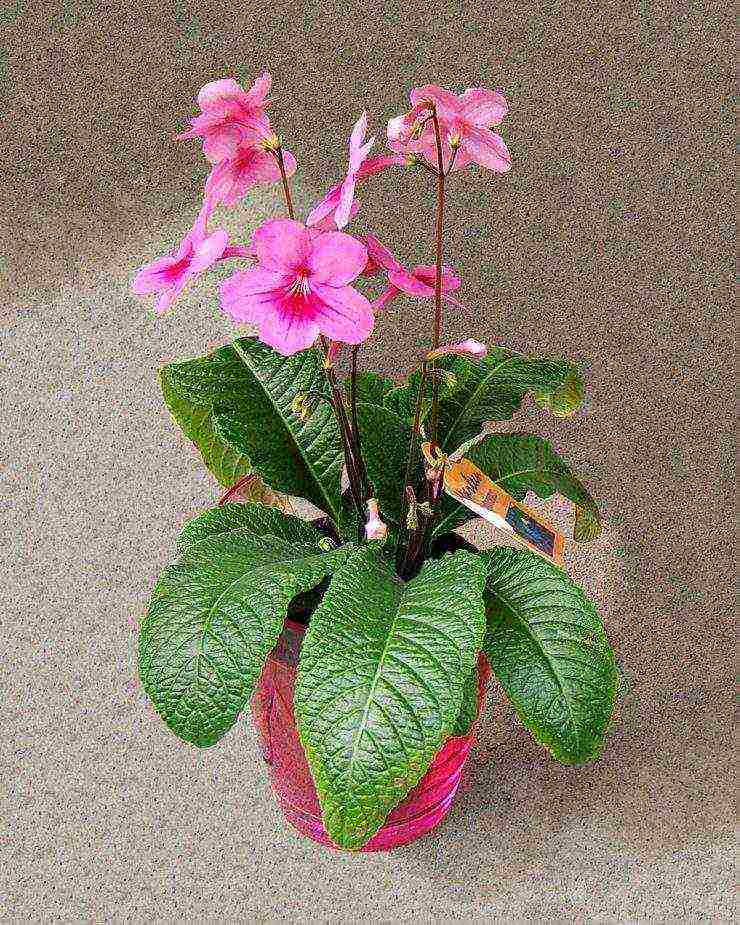




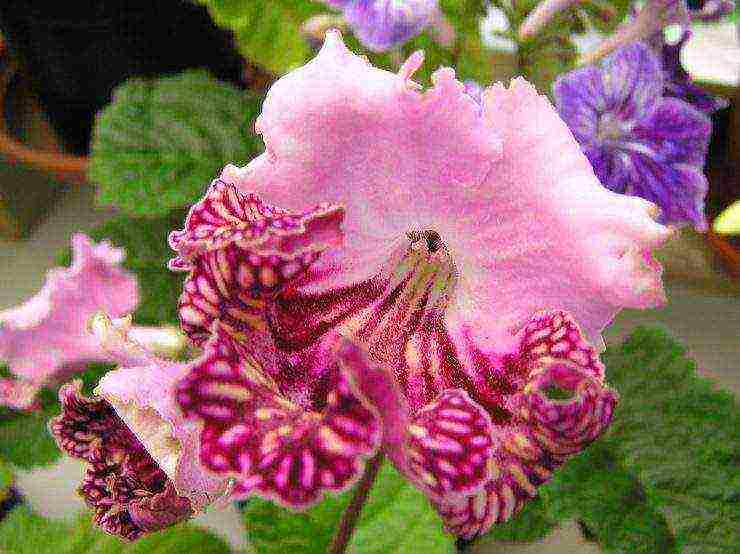

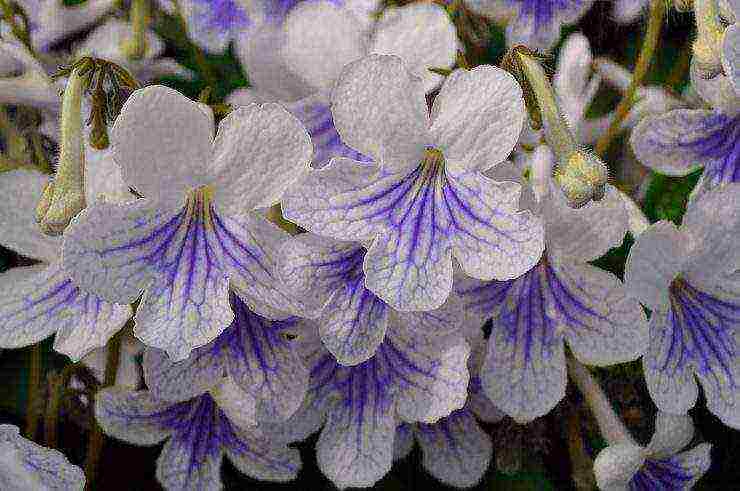




















Streptocarpus, a representative of the Gesneriev family, is rapidly gaining popularity among flower growers. It blooms profusely and for a long time, the colors are bright, interesting. In its natural environment, it is distributed in the forested mountains of South Africa and on the island of Madagascar.
There are about 130 wild-growing streptocarpuses that are not particularly decorative, but they are actively used by breeders to develop new varieties and hybrids. Over the past few years, the number of hybrids has exceeded a thousand copies.
Description of streptocarpus
Streptocarpus has no stem. Its leaves are fleshy, long, covered with soft nap, gather in a large rosette. From almost every axil of the leaf, a peduncle grows, covered with many flowers. Elite varieties have about 80 flowers on one peduncle. After flowering, the fruit appears - a twisted box with small seeds.
How it blooms
Bell-shaped flowers, the color is varied: white, pink, lilac, purple, with stains, speckled, 2-3 shades can be combined.Usually the corolla is large, about 8 cm in diameter, but there are species covered with small white flowers. There is a regularity: the smaller the corolla, the more flowers. There are hybrid forms with double flowers.
Leaves can reach lengths of up to 50 cm, color from light green to dark, there are variegated.
Home care for streptocarpus

Streptocarpus growing and care at home photo
In order for the flowering of streptocarpus to be lush and the flower does not get sick, it is necessary to study the rules of care and adhere to them.
Air temperature
Streptocarpus loves warmth. The optimal air temperature for the plant will be 22-25 ° C. In winter, when the flower goes into a state of dormancy, it is recommended to lower the temperature to 14 ° C. The plant is difficult to tolerate extreme heat.
The plant does not tolerate drafts, but in the summer you can take it out on the balcony or put it on an open window, just cover the doors at night or take it indoors.
Lighting
Good lighting is also important. Light is needed diffused, the length of daylight hours should be 12-14 hours. In summer, expose to the western or eastern windows. On the north side, there will always be a lack of light, and on the south, protection from direct sunlight is necessary. Phytolamps can be used for illumination.
Watering
Watering also has its own specifics. It is absolutely impossible to fill in the plant. If you are absent or forgot to water streptocarpus, then after receiving moisture, it will recover. But if the soil is heavily waterlogged, the plant will get sick and may even die.
To make streptocarpus comfortable:
- The root system of streptocarpus is more developed in width, shallow. You should choose not a tall pot, but a wide bowl.
- Choose the right soil, it should be loose and light enough. You can take ordinary soil and add 1 part perlite, deep peat or sphagnum moss.
- Water in moderation. About once every two days will be enough. Use bottom watering through a sump, or apply water from the top, moving around the edge of the pot to keep water out of the leaves. Lime is harmful to the plant, therefore, for watering, use water that has settled at least during the day.
- You cannot spray the plant. To increase the level of air humidity, you can put an aquarium, a container with water or wet expanded clay near the plant.
To streptocarpus bloom
- To ensure abundant and long-lasting flowering, it is necessary to transplant streptocarpus every year into a new substrate.
- Large leaves need a lot of nutrition. In the periods between transplants, apply fertilizers containing potassium, nitrogen, phosphorus. Nitrogen promotes good leaf growth, phosphorus and potassium help ensure consistent flowering.
Reproduction of streptocarpus by dividing the bush

How to divide a streptocarpus bush photo
This method is suitable for mature, overgrown plants.
- Water the flower, carefully remove it from the pot, peel the roots and carefully divide the bush, being careful not to damage the small roots.
- When planting, the previous level is observed, the root collar is not buried so that the plant does not start to rot, and it is not overestimated so that it does not dry out.
- In order for the flower to take root well, after transplanting it can be covered with a transparent bag or a cap from a plastic bottle.
After a couple of months, young plants will already begin to bloom.
Reproduction of streptocarpus leaf
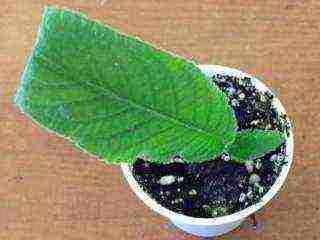
Reproduction of streptocarpus leaf photo
This method is quite simple. Cut off a leaf with a petiole and place it in water until roots appear. Can be planted directly into wet soil and covered with a plastic cup or bag.

How to cut a streptocarpus leaf for photo propagation
You can also root parts of the leaf. Cut the sheet across, dry the sections, sprinkle with crushed charcoal, plant in a loose, damp substrate and cover with foil. The stalk should be placed with its lower part in the ground at an angle of 45 °.
Toaster propagation

The planted parts of the streptocarpus leaf sprouted photo
The method consists in cutting the leaf along the central vein, from both halves the vein is cut off. Sections also need to be dried and processed with charcoal chips. The pieces need to be planted in the ground with a cut downward, deepening by 0.5 cm - very similar to two toasts in a toaster, which is why the method was so named. After 1, 5 months, the sections will become overgrown with "babies", but they can be planted in 4 months.
How to plant streptocarpus children
- Grown up children need to be separated from the uterine leaf and seated separately.
- It is very important not to plant the baby immediately in a permanent pot: streptocarpus will begin to build up green mass and you will not see flowering.
- It is important to gradually transfer the flower from the smaller cup to the larger one until it is time to plant it in a permanent pot.
How to separate the babies from the uterine leaf, the video will tell:
Transplantation of streptocarpus babies on video:
Use a versatile substrate or soil mixture consisting of five parts peat, two parts perlite, and one part humus. Water gently until the soil is completely dry. Immediately you need to make top dressing with potassium and nitrogen, but in a lower concentration than stated in the instructions for use.
When a young plant is preparing to bloom for the first time, it is better to remove the buds so that the streptocarpus finally gets stronger. Then transplant it into a shallow pot about 11cm in diameter. Use a mixture of ordinary earth, perlite and peat.
Streptocarpus from seeds at home

Streptocarpus seeds photo
This method is only suitable for patient gardeners with certain skills. Considering that most of the ornamental streptocarpus are hybrids, their varietal characteristics are lost when propagated by seeds.
After flowering, seed pods 5-7 cm long appear on the plant. Collect and dry them thoroughly.
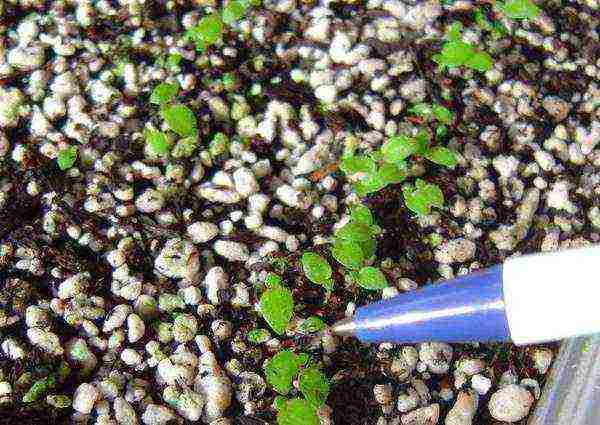
Streptocarpus from seeds photo of seedlings
- To germinate seeds, take low containers, place drainage on the bottom, fill the rest of the space with loose soil, you can mix it in half with perlite.
- Since the seeds are very small, it is enough to simply scatter them over the soil surface, then spray the crops, cover with a bag or glass, and grow at room temperature.
- When shoots appear, you need to ventilate the greenhouse so that drops of condensate do not fall on the shoots, the cover can be completely removed after 10 days.
- Water from a spray bottle, without moisture stagnation, provide good lighting, temperature within 22-25 ° C.
- Fortified plants dive in separate cups and continue leaving in the same mode.
- Expect flowering seedlings in 10 months.
Diseases and pests of the streptocarpus plant
Inspect the plant regularly to spot problems in time. Especially close attention is needed to the newly acquired flowers.
Actions upon detection of a disease:
- Isolate the diseased plant from the rest so that viruses and pests cannot move to healthy specimens.
- Damaged leaves, buds must be removed.
- If a spider mite and thrips are affected, the upper part of the plant must be treated with an insecticide.
- The defeat of gray mold and powdery mildew is treated with fungicides.
- In case of late blight or a virus (leaves will be covered with a mosaic of spots), the plant must be disposed of.
Additional tips for caring for streptocarpus:
- To try out the technology of care, first start 1-2 plants.
- Can be planted in transparent containers to make it easier to monitor the condition of the root system and the earthen ball.
- For beginner flower growers, it is better to start by caring for the plants obtained by dividing the bush.
- If you plant streptocarpus in a suitable pot, it will be compact in size and bloom abundantly.
Streptocarpus varieties with photos and names
The series of varieties "Bristol's" is very successful, flowering is especially long, even young "kids" bloom quickly.
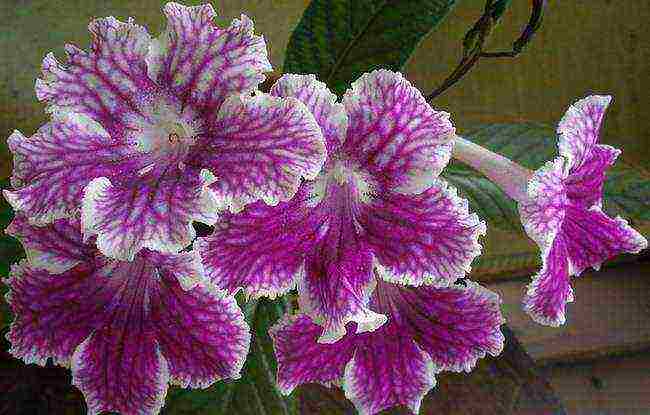
Streptocarpus Bristol`s Petticoats photo
"Bristol's Petticoats" - large flowers with wavy edges are painted white and covered with a pink mesh.

Streptocarpus Streptocarpus Bristol's Pajama Party photo
"Bristol's Pajama Party" - gramophone flowers are painted pink with white stripes.

Streptocarpus Streptocarpus Salmon Sunset photo
"Salmon Sunset" - flowers are smaller, but there are a lot of them. They have a salmon tint.

Streptocarpus Blue bells photo
"Blue bells" - corolla with a diameter of about 10 cm. Color - beautiful blue with a lilac tint.

Streptocarpus Alissa Streptocarpus Alissa photo
"Alissa" - flowers of a bright lemon shade, they are large, abundant flowering.
The beauty and variety of varieties, rather simple care will help create a real riot of colors in your home.


